Many Europeans countries share the tradition of preparing a kind of sweet bread, often with dried fruits, for religious holidays. Germany has Stollen and Italy eats panettone, while Russia makes kulich and Poland and Ukraine bake babka. In Czech Republic (and Slovakia), there’s vánočka, a rich plaited bread served for Christmas (vánoce means Christmas in Czech).
A little bit of history: In the beginning (sometime around the 14th century), there was an Old Bohemian bread loaf called calta. Through many years and hands, its shape progressively evolved to include braids, and the vánočka was born. Its first written mention appears in Jan of Holešov‘s Treatise on Christmas Eve, around 1400. In his list of Christmas traditions (fasting, generosity, exchanging gifts), the Benedictine monk mentions the following:
The fourth custom is that on the eve of the Birth of the Lord the believers enjoy a large white bread, a big vánočka, because it is on the eve of that holiday that was born and given to us in Bethlehem (the “House of Bread”) the white bread of heaven, our Lord Jesus Christ. The old people, showing good faith and just thoughts, placed these actual large white loaves on the tables and tablecloths, and beside them knives so that the whole family could cut the pieces they wanted for themselves and for the poor. But unfortunately, in this fourth custom, the devil equally pursues for himself a gross delusion of almost opposite thoughts; for, as I have heard, in some places Christians leave the bread on the tables and tablecloths on this holiday with knives not in honor and memory of the Christ’s childhood, but so that household gods could come at night and eat.
The fifth custom is worth mentioning too:
Christians are to enjoy more fruits on the Christmas eve than at any other time, since it is on the eve of that holiday that was born the selected and useful fruit, namely our Lord Jesus Christ.
In the middle of the cold Czech winter, this must have been quite a challenge. It is therefore not surprising that people resorted to dried fruits and nuts (which are also technically fruits). From there, it took only one small step to realize that a bread with dried fruits mixed into its dough was more exciting than a plain loaf with a bowl of prunes and raisins on the side.
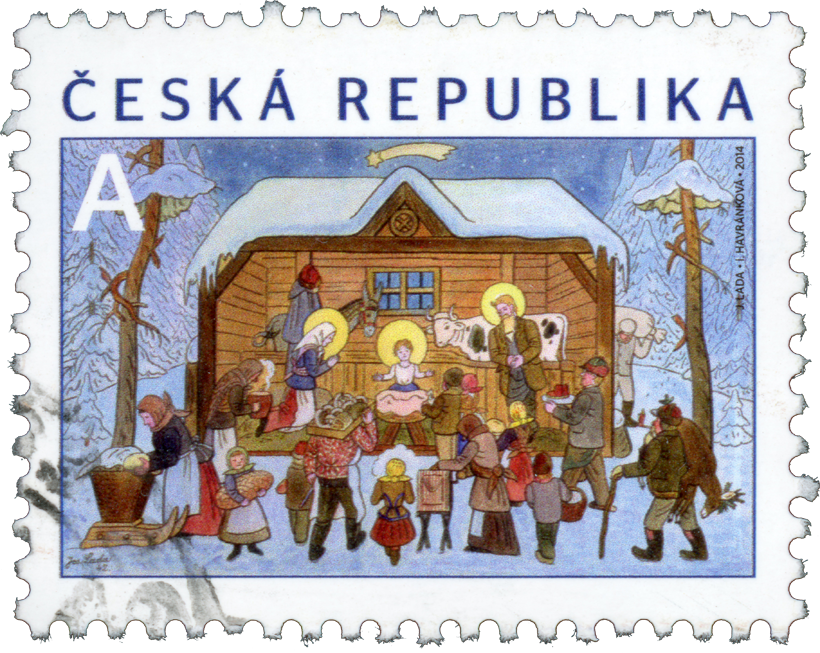
Baking vánočka was initially a privilege reserved for members of the preeminent bakers’ guild. Every Christmas Eve morning, six bakery journeymen dressed in white headed to the Prague Castle, carrying a huge vánočka with raisins on a long board, and delivered it to the royal table. Crowds of Praguers waited by Charles Bridge for the procession of the bakers’ guild, and in some years so many people gathered that the bakers had to be surrounded by the town guard in order to bring the vánočka to the castle without damage, which would put the guild to shame.
But in the 18th century, people started to bake vánočka at home, passing recipes from one generation to the next, each one with regional variations. The baking process became a ritual filled with tradition and superstition. For example, the housewife had to be dressed in a white apron and a white scarf. She had to make the dough in silence, and then jump up and down while it was rising. A burnt or cracked vánočka was a bad omen for the household. Some cooks added a coin to the dough, and the person who found it in their slice could expect riches and good health in the coming year.
My vánočka recipe has the approval of Our Lord Jesus Christ, and here’s why:
- It’s braided, which is a big part of what makes a vánočka a vánočka, as the braids are meant to represent the swaddling clothes of Baby Jesus. From my research, it seems that the traditional pattern consists nowadays of three braids of different sizes (4 strands, 3 strands, 2 strands) stacked together. Some recipes use fewer or smaller braids, either out of laziness or because many people don’t know how to make a 4-strand braid without consulting a book, or because the bread keep its shape better that way. That last point is worth considering, because with the 4-3-2 configuration, the bread tends to spread a little bit more during baking than my aesthetic sense would like, and reminds me more of an Aztec pyramid than bundled Baby Jesus. (In fact, some baking books explain how to make 6-strand braids that supposedly result in tall loaves, and I think that might be an even better match. I guess that gives me something to try for next Christmas.)
- It’s loaded with dried fruits and nuts. While other recipes I’ve seen call for just almonds, or almonds and raisins, and occasionally maybe lemon zest, I use considerably more fruits, both in terms of variety and quantity — raisins, prunes, dried cherries, chestnut cream (not visible in the pics), lemon and orange zest. Is more necessarily better? No, of course not, but in this case I think you can still notice all the different flavors in each bite. And there’s still plenty of bread — this is not a Christmas pudding!
- It’s heavenly light and airy, a quality that goes one step beyond the prescriptions in Jan of Holešov‘s writings. In my first attempts, the vánočka was a massive, dense loaf. I then switched to proportions and a preparation method similar to those of French brioche, and the result is much more pleasant.
Vánočka is eaten plain or with preserves/butter/honey, and sometimes toasted. With its rich fruit contents and airy crumb, I think mine is best eaten as is, a few hours after it came out of the oven. On the other hand, I love butter, so I’ve created a butter ice cream to solve the dilemma, letting me enjoy vánočka au naturel while getting my butter fix, not to mention my “cold dessert” fix. This too took quite a few rounds of experimentation, as butter doesn’t fit the nutrient bill of typical ice cream composition, especially when used in noticeable amounts. However, by first making a beurre monté, and using some Modernist Pantry Perfect Ice Cream powder (available here), I get a result that’s quite palatable. Note that the proportions make enough ice cream for about 8 servings if you have 2 scoops with each slice of vánočka. This is a good batch size for my machine, but you can scale and churn in batches if you need more, since the vánočka yields about twice as many servings.
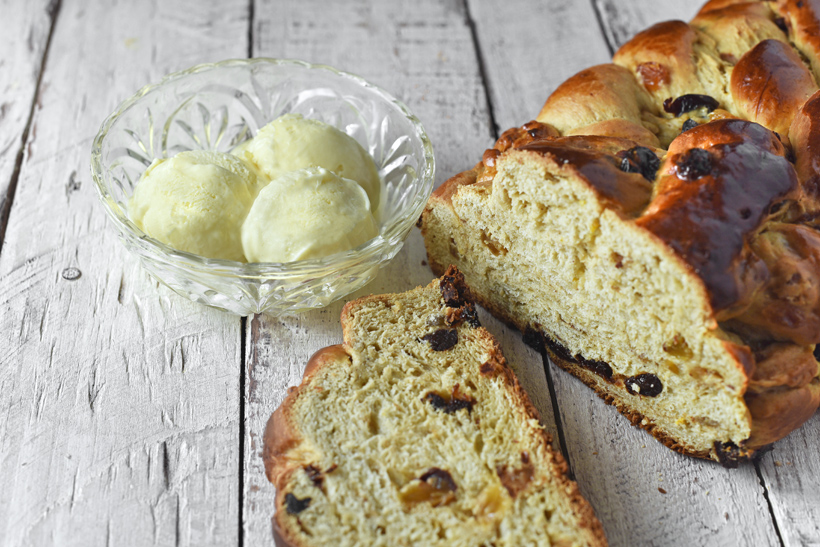
Vánočka sponge
Yields 1 vánočka
11 g active dry yeast
10 g sugar
75 g milk, lukewarm
75 g bread flour
- In a small bowl, mix the yeast, sugar, and milk. Let rest for 5 minutes.
- Transfer to the bowl of an electric mixer fit with the paddle attachment. Add the flour, and mix on low speed for 8 minutes, scraping the sides of the bowl a couple times if needed. Cover with plastic wrap, and let rest for about 40 minutes, until doubled in volume.
Vánočka dough
Yields 1 vánočka
vánočka sponge
80 g milk
110 g (about 2) eggs
45 g (about 3) egg yolks
375 g bread flour
80 g sugar
5 g salt
4 g orange zest, grated using a Microplane grater
2 g lemon zest, grated using a Microplane grater
2 g ground cinnamon
2 g ground star anise
0.3 g tsp ground nutmeg
155 g butter, softened
- Return the vánočka sponge to the stand mixer fit with the with paddle attachment. Mix in the milk, eggs, and egg yolks on low speed, scraping the bowl a couple times with a spatula.
- In a separate bowl or container, combine the flour, sugar, salt, orange zest, lemon zest, cinnamon, star anise, and nutmeg. Add to the dough in two additions, with the mixer still running on low. Mix until mostly homogeneous, scraping the bowl with a spatula as needed.
- Switch to the dough hook attachment, and knead for 5 minutes on low speed.
- With the mixer still running, add the softened butter in several additions, then knead for another 8 minutes (keep scraping a few times). Don’t panic if it looks like a greasy mess in the beginning: the dough must slowly absorb the butter, and then it will start forming a ball again.
- Cover with plastic wrap, and let stand in a warm place for 1 hour (I usually place the bowl on the stove top, with the oven on 200 F). Then, refrigerate overnight.
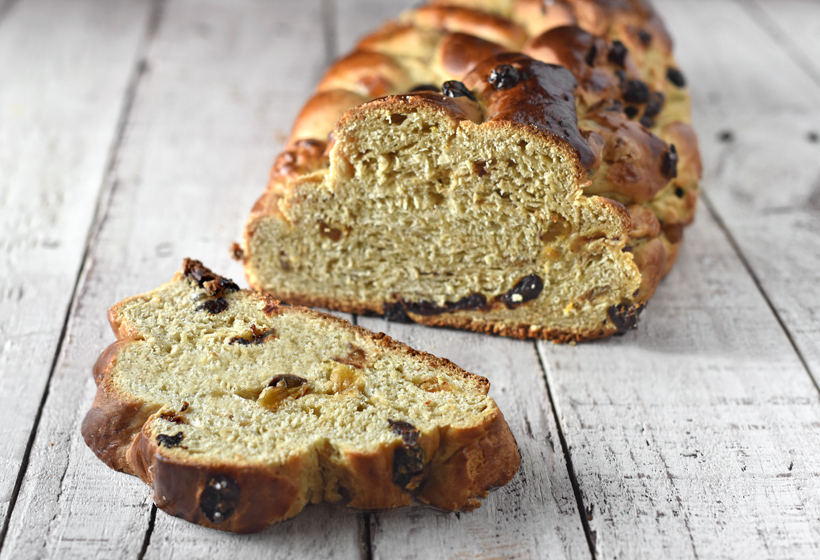
Dried fruit mix
Yields 1 vánočka
125 g golden raisins
75 g dried cherries
75 g prunes, quartered
60 g dark rum
- Place the raisins, cherries, prunes, and dark rum into a bowl, then stir with a spoon.
- Cover and let soak overnight.
Vánočka
Yields 1 vánočka (about 16 slices, 2 cm thick)
bread flour (for dusting)
vánočka dough
15 g (about 1) egg yolk
15 g milk
dried fruit mix
100 g chestnut cream
confectioner’s sugar (for dusting, optional)
- On a floured surface, spread the vánočka dough to a 16 cm x 32 cm rectangle (the dimensions aren’t very important at this stage), using a rolling pin. Cover the dough with about half of the dried fruit mix, then fold into thirds, and roll again. Repeat with the remaining dried fruits, but without rolling the dough.
- Divide the dough into 9 pieces, about 150 g each.
- Mix the egg yolk and milk in a small bowl to make an egg wash.
- Take 4 pieces of dough, and roll each one into a 40 cm long string of about 3 cm diameter. Form a braid with the 4 strands. You can use the method from Mirka van Gils’ video here (I recommend watching it no matter what, and not just for the braiding technique), or use one of the methods from Jeffrey Hamelman’s Bread: A Baker’s Book of Techniques and Recipes. The one I’m reproducing below (from Hamelman) works quite well, but feel free to try something different.
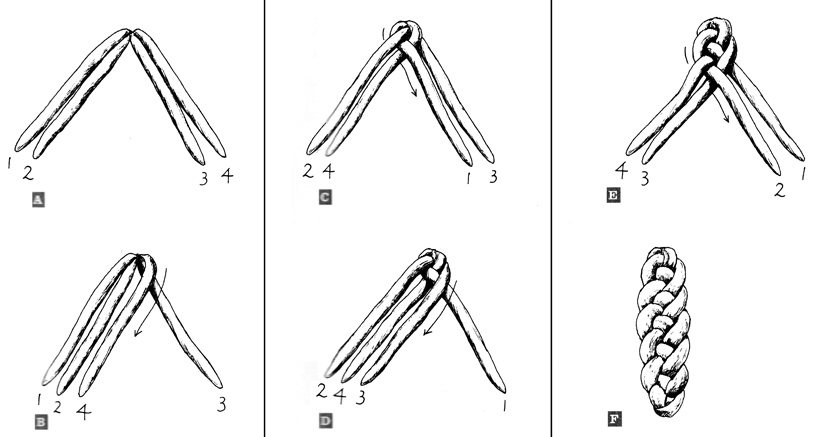
- Transfer this 4-strand braid to a baking sheet lined with parchment paper, where it forms the bottom layer of the vánočka. Spread slightly more than 1/2 of the chestnut cream over the braid, mostly in the crevices. Then brush the top with egg wash.
- Take 3 pieces of dough, and roll each one into a 40 cm long string of about 3 cm diameter. Form a braid with the 3 strands (again, check out Mirka’s video here). Place this braid on top of the previous one, pressing lightly to make them stick together. Spread the rest of the chestnut cream as above, and brush the top with egg wash.
- Roll each of the remaining 2 pieces of dough to a 40 cm long string of about 3 cm diameter. Form a “twist braid” with the 2 strands (you don’t need a video for that!), place on top of the previous layers, and press lightly.
- Let the vánočka rise for 30 minutes at 37 C / 100 F (a warm stovetop can work too).
- Place a dish of water on the bottom rack of an oven, and heat to 175 C / 350 F.
- Gently press the sides of the vánočka to make it narrower (it tends to spread during baking). Thoroughly brush with the egg wash, then bake for 45 minutes. Perfectionists will rotate the baking sheet in the oven around mid-time, because the heat is rarely evenly distributed in an oven. Check the internal temperature in several spots, and continue baking as needed until it reaches 82 C / 180 F.
- Transfer the vánočka to a cooling rack, and let cool. Optionally, dust with confectioner’s sugar.
- Cut into slices to serve.
Butter ice cream
Yields a bit over a pint / 16 scoops
25 g heavy cream
150 g butter, cold, medium dice
400 g milk
130 g sugar
30 g non-fat milk powder
0.2 g salt
1 g Modernist Pantry Perfect Ice Cream powder
60 g (about 4) egg yolks
- Heat the cream in a small saucepan over low heat. Whisk in the butter a little at time, always waiting until it’s completely melted before adding more. (Congratulations, you just made a beurre monté!)
- Add about 3/4 of the milk, 1/2 of the sugar, and all of the milk powder to the saucepan. Stir and bring to simmer, then remove from the heat.
- In a bowl, combine the remaining sugar with the salt and Perfect Ice Cream powder, then whisk in the egg yolks to a pale ribbon. Then, slowly add the butter mixture, stirring constantly.
- Return to the saucepan, and cook over very low heat to 85 C / 185 F, stirring constantly with a rubber spatula and scraping the bottom regularly. The custard will thicken considerably once past 82 C / 180 F (partly because of the hydrocolloids in the Perfect Ice Cream powder). Immediately remove from the heat, and pass through a chinois into a container set in a bowl of ice water. Mix in the remaining milk, cover, and let cool. Refrigerate for at least 4 hours.
- Chill in the freezer for 30 minutes, then transfer to an ice cream maker, and churn following the manufacturer’s instructions. Transfer to the freezer for at least 8 hours before serving.
- Below is the ingredient breakdown table that I used to tune the proportions, based on recommendations from Caroline and Robin Weir’s Ice Creams, Sorbets and Gelati.
| ingredient | weight | fat | MSNF | sugar | other solids | water |
|---|---|---|---|---|---|---|
| heavy cream | 25 | 9 | 1.3 | 14.7 | ||
| butter | 150 | 126 | 24 | |||
| milk | 400 | 16 | 36 | 348 | ||
| sugar | 130 | 130 | ||||
| non-fat milk powder | 30 | 25.3 | 4.7 | |||
| salt + Perfect Ice Cream powder | 1.2 | 1.2 | ||||
| egg yolk | 60 | 18 | 10.2 | 31.8 | ||
| total | 796.2 | 169 | 62.6 | 130 | 11.4 | 423.2 |
| percentage | 21.2% | 7.9% | 16.3% | 1.4% | 46.8% |


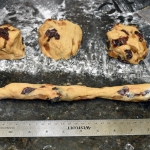

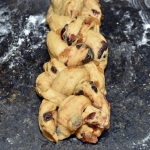
2 comments
That Vanocka looks perfect! I love how you have explained the braiding. Looks so pretty!
Thank you!